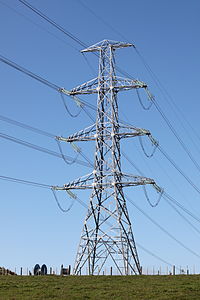
Photo from wikipedia
India is facing severe energy-related problems, including the deficiency of fossil fuel resources, greenhouse gas emissions, and an increase in power demand and supply gap due to overpopulation and growing… Click to show full abstract
India is facing severe energy-related problems, including the deficiency of fossil fuel resources, greenhouse gas emissions, and an increase in power demand and supply gap due to overpopulation and growing industrial needs. In 2018, the average power demand and supply gap was 1617 MW, indicating that there is a deficit of 23 × 109 kWh in the country. In the meantime, a massive increase in electricity prices has made the affordability of electricity very difficult for domestic and industrial users. The development of alternative and renewable energy sources is very crucial to overcome these problems. Wind energy has emerged as a sustainable energy option for India in this respect. At the same time, the wind industry is facing several challenges as well. This paper aims to develop a value chain model of the wind power industry, assess the competitiveness of the Indian wind power industry, and comprehensively analyze the factors that have a significant influence on the industry by using the “Five Forces Model.” We employed a hybrid research methodology. First, we developed a novel value chain model for the wind power industry. Second, we conducted semistructured interviews with industry professionals on different aspects of the wind energy sector. Third, we critically analyzed official statistics and the related literature along with the national policy structure and regulations. As a result, the Five Forces Model was developed. Five main stakeholders of the Indian wind industry, i.e., buyers, suppliers, competitors, substitutes, and potential competitors, were examined to assess their effect on the development of the wind power industry. Research findings reveal the present status, challenges, the rivalry environment, industry's situation in this environment, and the future projections of the Indian wind power industry. Although the Indian government announced several policies with an aim to boost the wind industry, little substantial action has been taken for their meaningful implantation. The major government policies which need improvements are Generation-Based Incentives, Wind Bidding Scheme, and Tariff Policy. Our findings also highlight that there exists a gap between the expected and actual performances of the wind power industry value chain. Essential policy recommendations for the development of the industry have been suggested, including institutional coordination and decision-making, feed-in tariffs, reformations in the grid structure, encouragement of differentiated business models, enhancing research and development activities, developing professional base, and the full range of government support. This study will serve as a guide for government and stakeholders by understanding the dynamic relationship among all the factors influencing the competitiveness of the Indian wind power industry.
Journal Title: Journal of Renewable and Sustainable Energy
Year Published: 2019
Link to full text (if available)
Share on Social Media: Sign Up to like & get
recommendations!